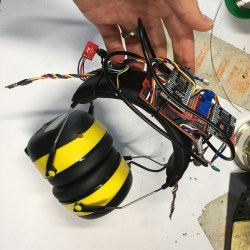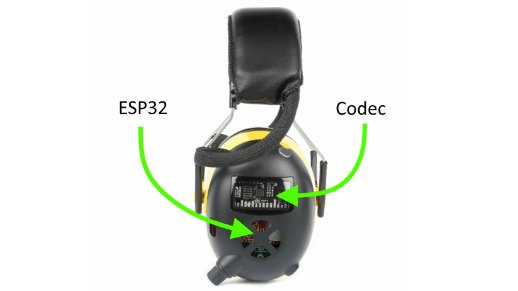[Pete Lewis] from SparkFun takes audio and comfort seriously, and recently shared details on making a customized set of Super Headphones, granting quality sound and stereo ambient passthrough, while providing hearing protection at the same time by isolating the wearer from the environment.
Such products can be purchased off the shelf (usually called some variant of “electronic hearing protection”), but every hacker knows nothing beats some DIY to get exactly the features one wants. After all, off-the-shelf solutions are focused on hearing protection, not sound quality. [Pete] also wanted features like the ability to freely adjust how much ambient sound was mixed in, as well as the ability to integrate a line-level audio source or Bluetooth input.

On the surface the required components are straightforward, but as usual, the devil is in the details. Microphone selection, for example, required a lot of testing. A good microphone needed to be able to deal with extremely loud ambient sounds without distortion, yet still be sensitive enough to be useful. [Pete] found a good solution, but also muses that two sets of microphones (one for loud environments, and one for quieter) might be worth a try.
After several prototypes, the result is headphones that allow safe and loud band practice in a basement as easily as they provide high-quality music and situational awareness while mowing the lawn. Even so, [Pete]’s not done yet. He’s working on improving comfort by using photogrammetry to help design and 3D print custom-fitted components.

















Noise cancelling headphones will suppress background noise, but let in the frequencies used by the human voice. These are good for things like flying light aircraft, where there is lots of background noise but you still want to hear your co-pilot or ATC.
I’ve always wondered why people don’t sell completely noise cancelling headphones. That’s something I’ve always wanted – something to tune out *all* the ambient noise, so that I could (for instance) take a nap in the motel that happens to be right next to the ambulance bays.
Is this a physical impossibility? Does anyone know why they don’t sell noise cancelling headphones for complete blackout?
Because $0.50 basic passive earplugs work better for blocking everything, cost less and tend to be quite squishy, so they can even stuffed in smaller containers?
Use’em when the power saw is screaming at me.
I tried some noise canceling earbuds – not the models with the best test results, but an affordable option – and they make it harder to hear a number of annoying sounds than you’d think. They had a separate “transparency mode” for if you need to hear voices well. Mainly dealing with voices from another room or droning/humming/fans were the strengths of active cancellation rather than attenuation although as earbuds they do some of both. Part of that is because you’d have to have way more than 20-30dB of attenuation to not find a noise distracting. If you can actively cancel out most of it, letting it fade into the background noise, and especially if you then play something else over the top, you can more easily ignore it to sleep. I could use both at once, but the ear protection headphones are bulky.
I have always assumed that 100% cancelling was impossible because of conduction, gaps in sealing and multipath transmission of sound (related to the first and second). I think it is pretty hard to create a perfect inverse sound at the ear drums (for superposition cancelling). They have gotten better over time by using multiple microphones. FWIW, those earplugs don’t cut 100% though they do work pretty good.
All the aircraft head sets I’ve seen and used have an input for radio and intercom – no need to treat human voice frequencies specially in the cancelling. The poor sap in the back seat that doesn’t get a set goes completely unheard. The pro-sumer noise cancelling headphones don’t do it for sure – they just aren’t perfect.
The ear canals aren’t the only ports to your auditory system, there’s also sound picked up by the skull and other bones and active noise cancelling cannot eliminate that. And there’s another caveat, noise cancelling will reduce sound quality. Many people never notice that, because they are either used to crappy sound or half deaf by (ab)using earphones all day long. Unfortunately, affordable closed hi-fi headphones are a thing of the past, they vanished into obscurity during the last three decades.
“they vanished into obscurity during the last three decades.”
About the time lower audio quality broadcasts became popular?
Instead of broadcasts, I meant lossy compression audio transfers.
It coincides with portable “personal stereo” things becoming cheap mass products. Their digital successors finally killed hi-fi, thereby eliminating the demand for high quality audio. Now we’re back to the sound quality of a low-end 1930’s radio with a balanced armature speaker and worn out tubes on both ends.
Do they really reduce sound quality?
Especially in the lower price range, enabling noise cancellation often also happens to eliminate resonance in the headsets themselves, getting you to a much flatter response in the first place.
They do all add a 15-20 dB white or brown background noise, but that’s about the worst they do.
Even just relaxing or tighten (not even closing) your jaw produces a much higher distortion than that.
And about sound transmission via bones? The better systems are really great about eliminating that too. Especially the in-ear systems which have a mic inside and have a calibration procedure where they take the present ambient noise as a reference level for estimating the wet paths as well.
Even for an over ear – if noise cancellation was your primary concern – placing a mic on the cheek bone – essentially a reverse bone conductive headset – would also get you real time measurements of the wet paths. You could even adjust on the fly to changes in the wet paths, that way.
What’s still a challenge tough is the equalizer itself. If you know the dry and wet paths, have directional mics, and reference measurements, then theoretically FFT + delay elements for the wet paths give you a perfect counter signal.
In reality, building an equalizer is a compromise between EITHER low latency OR getting the phase right. If you accept the latency, then you can filter periodic noises out perfectly.
But not voice. While voice remains recognizable even when badly approximated by only a handful of discrete frequencies and low sample rate, a real voice contains a lot of extra, non-periodic noise, especially in the higher frequencies.
Noise cancelling headsets still get rid of the “melodic” / harmonic parts of voices nicely. But consonants pose a difficulty, and do do hissing sounds.
Actually, you can get a lot more good hi-fi stuff, for much better prices, and less snake oil than I remember. It’s just that you have to go look for it on the internet, you can’t just stumble on it. It also tends to have less knobs to twiddle. I wish it had loudness compensation like the old stuff often had.
But at least you usually can do digital eq’ing now. As for headphones specifically, I admit they don’t seem popular. Bluetooth is popular, but a lot of times isn’t reaching CD quality. You’ll find excellent IEMs for the price of fairly mediocre headphones or wireless earbuds. They work very well as long as they fit your ears.
ANC doesn’t have to hurt sound quality that badly; anytime you’re using it it should be a gain anyway as you’re bringing down the noise floor.
I can understand not wanting to stuff foam in your ears all day long, it gets tiresome. Have you tried earmuffs from the rifle range? Those can be very comfy and block out just about everything. In fact a pair of my favorite headphones are shooting earmuffs with bluetooth. They’re pretty close to what OP built, in fact. You can turn off the electronics entirely and they block out just about everything.
They’re very much like the construction kind, but I concur they work well although the regular kind is a bit big to sleep in. There’s some slim models, but I’ve not tried those. I find I can tolerate some earbuds/iems longer than earplugs, so wearing them under earmuffs is a pretty ideal cheap alternative to the electronic kind of earmuff for me.
If you have sufficient microphones far enough away from you to detect the patterns in the incoming spherical pressure field you can produce an out of phase duplicate that cancels it. The mikes let you learn about the incoming sound before it reaches you as the electrical signal travels faster than the speed of sound. If you have enough computing power you can be selective about the frequency response for each point on that sphere so that you can e.g. ignore the person on your left while listening to the person on your right etc. It is doable but a highly complex and computationally intensive task that must operate in real-time.
I have a Sony WH-1000XM3 i use extensively in my open office at work. I have no experience with the newer models, but expect them to function the same way, if not better.
They lower the noise-floor extremely efficiently at pretty much all frequencies except very high frequencies like cutlery on a plate or the occasional very high-pitched voice, but both are almost unnoticable if i have music on at the same time, even at very low volume.
I’ve been using them almost daily for 2 years now and they still work great, only complaint is they can’t charge and be switched on at the same time, but the battery lasts more than a workday so only a problem if i forget to plug them in when i leave.
Those are called Sony WH-1000XM5
There’s a lot to be said for visually conspicuous headphones like these regardless of what they actually do – stops people trying to talk to you.
Wow … the project owner’s website shows quite some attention to detail. This is definitely “a hack”. :)
Noise-cancelling earbuds are a game-changer for me. They make long flights and noisy environments much more bearable.
I turn off the eraring aids. The dedicated external microphone helps a lot in tricky environments such as a cocktail. My new hearing aids supports bluetooth. Unfortunately, the digital latency adds an echo, making the sound worse.
For noisy flights like in a small aircraft, I find that ANC earbuds work extremely well for cancelling low frequency rumble. Ear muffs work well at mid to high frequencies, but low frequencies can still be overpowering. ANC earbuds + ear muffs is a golden combo.
Interested in the OP’s idea though. Very cool.
Absolutely loving my new eWave Wireless neckbands! The sound quality is top-notch, and the convenience of not dealing with tangled wires is a game-changer. 👌 #eWaveWireless #Neckbands
Hi all,
Thanks for reading and all the comments! Although it could be possible with more development, this project is not intended to be a DIY version of “traditional” noise-cancelling headphones. The focus of this project is to protect the users ears from extremely loud ambient sounds (like acoustic drums) and then actually hear those ambient sounds at a safe volume. The microphones are solely used to capture the loud environment sounds (distortion free, full audio spectrum, zero latency) and then send that audio signal to the earmuff speakers at a safe volume.
On another note, I have been experiencing some RF interference at a specific drum rehearsal location, and can’t seem to remove it. I reached out to MicBuilders on groups.io. A few ideas have been presented and we are working towards a solid solution, but if you may have any insight into RF mitigation, I would be greatly appreciated your thoughts. Thanks! -Pete